
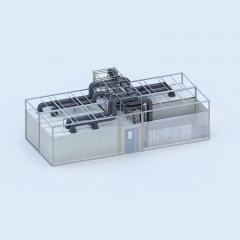
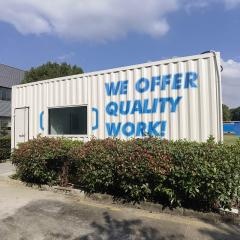
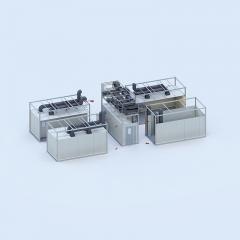
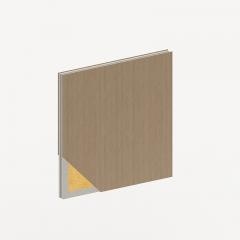
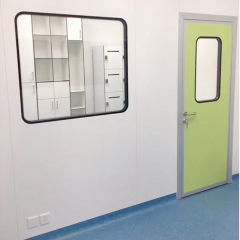
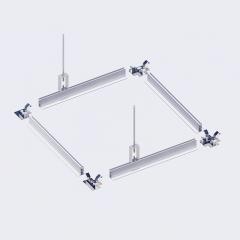
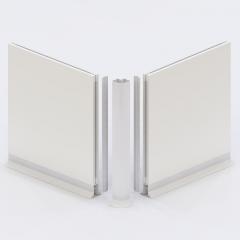
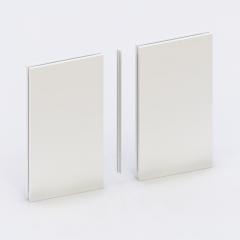
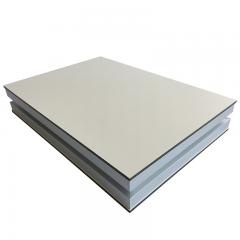
The concentration of suspended particles in the clean room is controlled, and its construction and use method is to minimize the particles that enter, produce, and stay in the room; other indoor parameters, such as temperature, humidity, and air pressure, are controlled as needed. The first half of the definition basically describes what is clean, which is a room that minimizes the entry, generation, and retention of particles. To achieve this, first, a very large amount of supply air must be filtered through a high-efficiency filter. The purpose of this air supply is: (1)Dilute and remove particles and bacteria emitted by indoor personnel and equipment; (2) Pressurize the room to ensure that dirty air does not flow into the clean room. Secondly, the building materials of the clean room do not produce particles and are easy to clean. Finally, clean room personnel use clothing to cover their bodies to minimize the particles and microorganisms they emit. These measures and other similar measures to minimize the pollution introduced, generated, and retained using clean rooms. The clean room can also control temperature, humidity, sound, lighting, and vibration. But these characteristics are not exclusive to clean rooms. The clean room is a modern thing. Although the source of clean room design and management can be traced back to anti-infection measures in hospitals more than 100 years ago. However, the demand for a clean environment in the manufacturing industry was only put forward in modern society. The reason why the manufacturing industry needs a clean room is because people, production equipment, and buildings all produce pollution. As explained, people and equipment can produce millions of particles, and general building materials are also easily broken. But the clean room can control the spread of particles, so that the production can be carried out in a clean environment. We are clean room equipment manufacturers.Welcome inquiry.
Since the Spring Festival, the whole country has been shrouded in the heavy atmosphere brought by the new coronavirus pneumonia. Wuhan is closed and new cases have appeared in other parts of the country. Viruses are raging, touching people, preventing and controlling epidemics. The medical industry is always at the forefront. As the upstream industry of the medical industry, the clean room industry has also stepped onto the battlefield of epidemic prevention. The clean room industry mainly serves the design and construction of wards, laboratories, testing rooms, and operating rooms in the medical system. This article will discuss how the clean isolation ward plays a role in the prevention of epidemic viruses in the case of this new coronavirus. First, we must clarify the concept of isolation wards and general clean room wards. Isolation ward refers to a ward that gathers patients diagnosed with infectious diseases and uses physical measures to isolate them from other patients, thereby preventing pathogenic microorganisms from spreading through the air and protecting uninfected people from the threat of air pollution. Compared with ordinary wards, isolation wards have more guarantees in terms of manpower, material resources and technology to ensure good and timely treatment of patients diagnosed with infectious diseases. 1. Strict zoning. The clean area, semi-contaminated area, and contaminated area of the infectious isolation ward are strictly partitioned and rationally arranged. A contaminated area is an area where there are patients or patient secretions, such as wards, toilets, bathrooms, toilets, and dirt clothes storage. The clean area refers to the area without the above pollution, such as the warehouse, pharmacy, sterilization room and duty room in the isolation area. The semi-polluted zone refers to the transition zone between the two, such as buffer rooms, isolation corridors, and preparation rooms. The three areas are well divided and have clear isolation signs and functional attributes. After this step is completed, the air will not be cross-contaminated by technology, equipment, personnel control, etc. 2. Differential pressure control. Air flows from a high place to a low place. After the functional zoning of the isolation zone is planned, the pressure difference control is done to effectively prevent the air in the isolation ward from flowing out of the isolation zone. According to the air pressure difference between the isolation room and the neighboring room or outside, the isolation ward can be classified as follows: Class S (standard pressure difference): used for isolation through contact transmission and mouth foam transmission. Type N (negative pressure difference): used for isolation of airborne diseases. Type P (positive pressure difference): used for isolation of patients with low immunity, such as: organ transplant patients As we all know, this new coronavirus is spread by mouth-foam transmission and contact transmission. ...
The company has been focusing on the production and development of clean room materials, clean room equipment, clean room engineering, etc. In the customer first, integrity first service concept. 2019.12.23 Vietnamese customers who have followed for months have finally placed an order. For the past few months, we have been patiently communicating with customers about related issues. The type of material, relevant dimensions, accessories, etc. have all been confirmed in detail. Customers trust us very much. They have also visited our factory and highly appreciated our products and strength. This order includes clean room materials,clean room sandwich panels, clean room doors, clean room windows ... Welcome inquiry and purchase from Wonzone!
The electronics industry's requirements for clean rooms in cleanrooms need to be equipped with air showers, clean sheds, FFU purification units, high-efficiency filters, high-efficiency air outlets, and transfer windows. Your requirements are up to standard if these equipments are not equipped. The electronics industry's requirements for clean rooms in clean rooms: clean rooms are also called clean workshops, clean rooms, clean rooms. There are many types of production processes in electronics factories, and integrated circuit production (divided into photomasks, front processes, and rear processes) Process), Pingnan display production (divided into LCD, PDP, TFT, VFD, picture tube), silicon material production (monocrystalline silicon, polysilicon), optical fiber production, card manufacturing, surface mount (SMT), separation device production ( Power first, second and third level tubes, capacitors, resistors), complete machine assembly production (set-top box, digital projector, electronic digital camera), automatic control component production (sensors, actuators), etc. Due to the variety of production processes, the requirements for cleanliness levels are different, high is high, and low is low; the requirements for particle size control are also different, ranging from about 0.1 to 5um; the requirements for temperature and humidity control are relatively high For example, the previous steps of integrated circuits generally require a base temperature of 22 ° C (accuracy ± 0.1 to ± 1 ° C) and a relative humidity base of 40% (accuracy ± 2 to ± 5 ° C; the gradient level required for positive pressure values is The degree of cleanliness changes from high to low, the difference is 5 ~ 10Pa. The cooling load of the dust-free workshop in the electronics industry is much larger than that in other industries, and the unit cooling load is 400 ~ 500W / ㎡. Due to the large cooling load, cooling is also generally required in winter, which is a characteristic of the electronics industry. There are many types of harmful gases generated in the production process of the electronics industry, and the quantities are also large, so the amount of exhaust air and fresh air required is also large. The energy saving measures of new exhaust air are also one of the industry's characteristics. Before discharge, treatment should be done to make the exhaust air load environmentally friendly. The production process of the electronics industry requires antistatic and anti-vibration requirements, and there are many types of bulk gases and special gases, which require high purity and cleanliness: 1. Noise level (empty state) of 10,000-level clean room in electronics factory: should not be greater than 65dB (A) 2. The clean room in the electronics factory's clean room should not be less than 60% full, and the horizontal unidirectional flow clean room should not be less than 40%, otherwise it will be a partial unidirectional flow. 3. The static pressure difference between the ...
First, the clean room of the pharmaceutical industry should be equipped with automatic monitoring and control devices for the purification air withering system. The device should have functions such as parameter detection, automatic parameter adjustment and control, automatic conversion of working conditions, equipment status display, interlocking and protection. Second,During the operation of the purification air conditioning system, the real-time display and recording of the static and dynamic operation and related parameters of the air cleanliness, temperature and humidity of the medical clean room (area), indoor pressure difference with detection requirements, purification air conditioning units, etc. And critical parameters such as the supply air volume should be alarmed. Third, the fan of the purified air conditioning system should be controlled by frequency conversion. Air volume sensor and display should be set on the main air pipe. Fourth, the electric heating and humidification of the purified air conditioning system should be interlocked with the blower, and there should be no wind and over-temperature power-off protection. When using electric humidification, no water protection should be set. The metal duct of the heater should be grounded. Fifth, the monitoring and control of purified air-conditioning cold and heat sources and air-conditioning water systems shall comply with the relevant provisions of the current national standard "Code for Design of Heating Ventilation and Air-conditioning" GB 50019.
Clean air-conditioning technology is also called clean room technology. The definition of clean room: In addition to meeting the general requirements for temperature and humidity in air-conditioned rooms, through various facilities and strict management in engineering technology, the indoor particulate content, air flow, pressure, etc. are also controlled to a certain range. Inside, this particular space is called a clean room. Typical application areas of clean air-conditioning technology include: microelectronics industry, pharmaceutical industry, food industry, etc. 1) Microelectronics industry The microelectronics industry is currently the industry with the highest requirements for clean rooms. The production and development of large-scale and ultra-large-scale integrated circuits (LSI and LSI) and liquid crystal displays (LCD) have increasingly higher requirements for dust control. In addition, modern industry In the production of liquid crystal and optical fiber, there are also high requirements for cleanliness. 2) Pharmaceutical industry Pharmaceutical production: The National "GMP" sets different requirements for the cleanliness of the pharmaceutical production environment. For the preparation of bulk drugs, powders, injections, tablets, large infusion production, filling and other processes, clean standards for clean areas and control areas have been formulated. Hospitals: Leukemia treatment rooms, burn wards, prevention of acute infectious diseases, and surgical operating rooms must also adopt clean technologies according to specific conditions to prevent bacterial infections in the air and play an environmental protection role in treatment. Medical scientific experiments: For the scientific scientific experimental processes such as breeding of experimental animals and genetic engineering, a clean environment is also required to obtain effective results. 3) Food industry Food aseptic packaging (such as flexible packaging of fresh fruit juice, milk, etc.) needs to complete the packaging process in a clean environment. 4) other Such as aerospace industry, precision machinery industry, instrumentation industry, fine chemical industry, etc., all have widely applied clean technology.